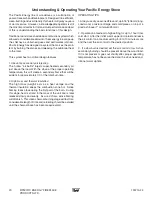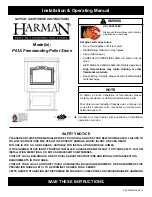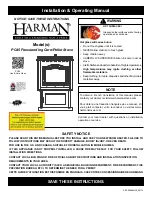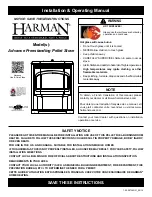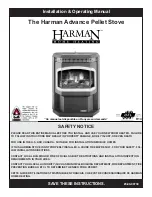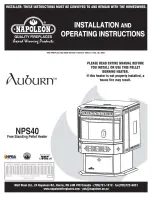
130715-24
5
©PACIFIC ENERGY FIREPLACE
PRODUCTS LTD.
2. Too much draft may cause excessive temperatures in the
appliance. An uncontrollable burn or a glowing red stove
part or chimney indicates excessive draft.
3. Inadequate draft may cause backpuffing into the room
and plugging of the chimney. Smoke leaking into the room
through appliance and chimney connector joints indicates
inadequate draft.
Ash Removal
Caution: Ashes are to be removed only when the woodstove
is cold.
Whenever ashes get 3 to 4 inches deep in your firebox, and
when fire has burned down and cooled, remove excess
ashes. Leave an ash bed approximately 1" (25 mm) deep
on the firebox bottom to help maintain a hot charcoal bed for
future fires.
Optional Ash Cleanout system:
The ash dump handle is
located under the ash lip on the left hand side behind the
lower grill. To operate ash dump, remove the lower grill, pull
handle out 1/2"(13mm) and turn clockwise. This will unlock
the ash dump and allow it to open. Hold handle open while
pulling ashes into the opening. Avoid large embers as these
still contain heat value. Release handle and push in to lock.
Ensure ash dump door is properly engaged. Fill the cavity
with the remaining ash level with the firebox floor. Lift and pull
out ashpan and discard ashes into metal container. Replace
ashpan and ensure it is seated properly.
Do not burn with ash dump door open. Doing so will cre-
ate a hazardous condition. Always leave about 1"(25mm)
of ash when cleaning.
Disposal of Ashes
Ashes should be placed in a metal container with a tight fit-
ting lid. The closed container of ashes should be placed on
a non-combustible floor or on the ground, well away from all
combustible materials, pending final disposal. If the ashes
are disposed of by burial in soil or otherwise locally dispersed,
they should be retained in closed container until all cinders
have thoroughly cooled. Other waste should not be placed
in this container.
Storing Wood Beneath Unit
It is possible to store wood between the stove pedestals, un-
derneath the unit. The wood must not extend further forward
than flush with the pedestals. Do not store paper or other
stove lighting devices within the pedestal area. Although this
is possible it is not recommended. NOTE: Refer to local fire
codes, CAN-B365 and NFPA 211 in the U.S..
WARNING: IF YOU CHOOSE TO STORE WOOD BENEATH
YOUR UNIT, EXERCISE EXTREME CAUTION WHEN LOAD-
ING THE WOODSTOVE. EMBERS CAN FALL AND MAY
IGNITE WOOD BENEATH STOVE.
WARNING: No alteration or modification of the combus-
tion air control assembly is permitted. Any tampering
will void warranty and could be very hazardous.
WARNING: Do not use grates or andirons to elevate the
fuel. Burn directly on the fire bricks. Replace broken or
missing bricks. Failure to do so may create a hazardous
condition.
Restarting After Extended or Overnight
Burns
1. Open door and rake hot embers towards the front of the
woodstove. Add a couple of dry, split logs on top of em-
bers, close door.
2. Adjust air control to high and in just a few minutes, logs
should begin burning.
3. After wood has charred, reset air control to desired setting.
4. To achieve maximum firing rate, set control to “High”
position(all the way to the left). Do not use this setting
other than for starting or preheating fresh fuel loads.
DO NOT OVERFIRE THIS Woodstove: Attempts to achieve
heat output rates that exceed woodstove design specifica-
tions can result in permanent damage to the woodstove
and chimney.
Over Firing
Over firing can be caused by operating the unit with the door
open, damage to door gaskets allowing excess air to enter
the firebox, the use of kiln dried lumber, mill ends or paper
waste and prolonged or continual use on a high burn setting.
Heat Output Calculation
Seasoned wood has approximately 7500 BTU's per pound.
The calculation is as follows:
Experience will give you the right settings for proper
combustion and efficient burning. Remember the correct air
inlet setting is affected by variables such as type of wood,
outside temperature, chimney size and weather conditions.
With practice, you will become proficient in operating your
woodstove and will obtain the performance for which it was
designed.
Proper Draft
1. Draft is the force which moves air from the appliance up
through the chimney. The amount of draft in your chimney
depends on the length of the chimney, local geography,
nearby obstructions and other factors.




















